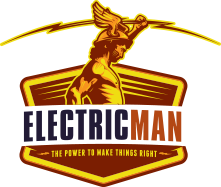LED Lighting
LED lighting has numerous benefits including sustainability & efficiency. Contact ElectricMan for LED lighting information.

LED Lighting Benefits
LED lights have grown in popularity over the past few years. They come in different styles and sizes and have the potential to fundamentally change lighting as we know it. The US Energy Department estimates that more than $30 billion could be saved by 2027 should everyone transition from conventional lighting to the use of LED lights.
Basically an energy saving alternative to traditional lighting, it is more powerful and efficient than other available options. What makes them so attractive?
High Energy Efficiency
LED lights are energy savers, consuming much less energy than other types of lighting – incandescent, fluorescent, or halogen. The ability of LEDs to give off a one-directional beam, while others give off lights that splay about in all directions, is what sets it apart from the rest. Residential LEDs, for instance, use 75% less energy than incandescent lighting and about 50% less than halogen lights.
Long Estimated Operational Life
Coupled with high energy efficiency, long life makes for the major benefit of LEDs. LED lights do not easily fatigue or burn out. They have an outstanding estimated operational lifetime of about 50, 000 hours or more. The US Department of Energy estimates its estimated lifetime to be 25 times longer than incandescent lighting.
Eco-Friendly
Conventional fluorescent bulbs are known to contain chemicals like mercury that damage the environment. LED lights do not contain the toxic chemicals that make up traditional lighting. Thus, they reduce your carbon footprint by about a third. LED lights are also 100% recyclable.
Rugged & Sturdy
LED lights are designed with sturdy components that make them rugged and resistant to damage under rough conditions. Made from diodes and soldered lead connections, they come without glass enclosures and filaments that make up other light bulbs. This makes them resistant to vibrations and shocks, as well as certain external impacts.
High Flexibility
An LED can be programmed using different controls – color, distribution, and light. This is possible thanks to the ease with which it gets dim. Unlike fluorescent bulbs that are dimmable up to 30% of their full brightness, LEDs are dimmable only up to 10% of their full brightness. This makes them less disruptive and ideal for such fantastic effects as daylight sensing.
Burn Hazard & UV Emissions
Traditional lightings possess a burn hazard when used in residential settings, thanks to their high heat emission. They are a risky choice for areas where they can come in contact with the skin. Perhaps worse than that is their emission of UV rays. With LEDs producing little infrared and minimal heat, they also produce zero UV emissions.
Frequent Switching
The diodes that produce light in LED bulbs light up the instant an electron crosses it, achieving full brightness immediately. This is contrary to HID and fluorescent lamps which can take up to 3 minutes to achieve full brightness. This improvement allows LEDs to withstand any damage that the others face from frequent switching. Frequent on and off switching affects neither its lifetime nor light emission.
The benefits of LED lights are clear for all to see. The most captivating of these might be its ability to reduce your long term energy bills. However, as you would have found, LED lights provide much more benefits than that and should take over your lighting system.
